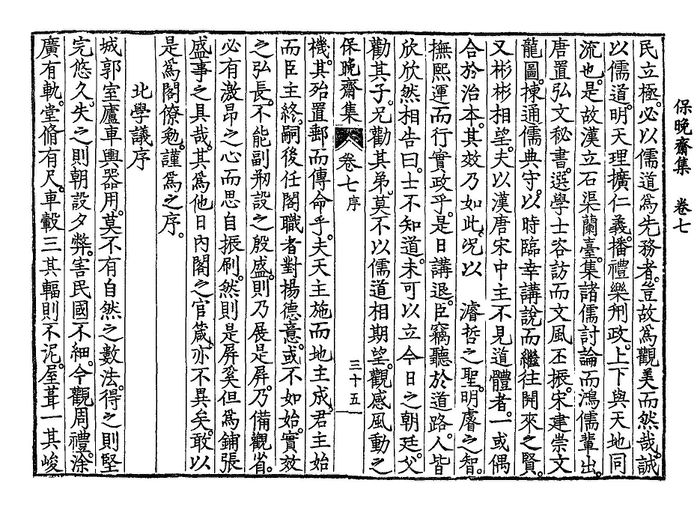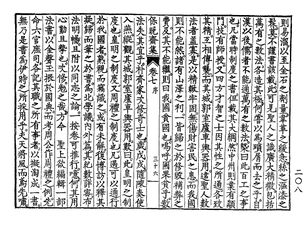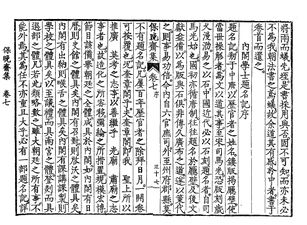"(Translation) 徐命膺 北學議序"의 두 판 사이의 차이
(→Introduction) |
|||
| 69번째 줄: | 69번째 줄: | ||
|- | |- | ||
|} | |} | ||
| − | + | <!-- | |
=='''Discussion Questions'''== | =='''Discussion Questions'''== | ||
# | # | ||
| 76번째 줄: | 76번째 줄: | ||
=='''Further Readings'''== | =='''Further Readings'''== | ||
| − | + | ||
<div style="color:#008080;"> | <div style="color:#008080;"> | ||
* View together with '''~~'''. | * View together with '''~~'''. | ||
</div> | </div> | ||
| − | + | ||
* | * | ||
* | * | ||
| 214번째 줄: | 214번째 줄: | ||
[[Category:2019 JSG Summer Hanmun Workshop]] | [[Category:2019 JSG Summer Hanmun Workshop]] | ||
[[Category:Advanced Translation Group]] | [[Category:Advanced Translation Group]] | ||
| + | --> | ||
2022년 2월 15일 (화) 01:17 기준 최신판
| Primary Source | ||
|---|---|---|
 |
Title | |
| English | Preface to The Commentary on Puk'ak | |
| Chinese | 北學議 序 | |
| Korean(RR) | 북학의 서(Bukagui Seo) | |
| Text Details | ||
| Genre | Literati Writings | |
| Type | ||
| Author(s) | Sŏ Myŏngŭng 徐命膺 | |
| Year | 1822 | |
| Source | Korean Classics and Literati's Collection of Writings (한국고전종합DB) | |
| Key Concepts | ||
| Translation Info | ||
| Translator(s) | Samuel Chan Sai Hay 陳世熙 진세희 | |
| Editor(s) | Samuel Chan Sai Hay 陳世熙 진세희 | |
| Year | 2019 | |
Introduction
“Introduction to Discourse on Puk'ak 北學議序” is an introductory piece written by Sŏ Myŏngŭng 徐命膺 for Discourse on Puk'ak 北學議, a foundational text of an emerging school of thought in 17th century Choson called the School of Puk'ak (literally translated to Northern Learning). The introduction explains the background as well as some of the motivations that prompted many thinkers of Sŏ’s time to embrace the new philosophy of Puk'ak. For readers who are unfamiliar with relevant history, this introduction serves as an excellent introduction to the rise of Puk'ak, an important episode in Choson intellectual history with which any serious Choson history students ought to familiarize themselves.
The School of Puk'ak gained currency in the Choson intellectual sphere around the early 18th century, introducing a country-wide debate and re-examination of how Choson ought to strengthen itself. Treating the relatively more technologically advanced Qing dynasty as a model of economic and social reform, proponents of Northern Learning asserted that mastery over material processes, especially those related to agriculture, means of production and commerce, was the panacea for the ills of Choson. In particular, together with Hong Taeyong 洪大容 and Pak Chiwŏn 朴趾源, Pak Cheka 朴齊家, the author of Discourse on Puk'ak, espoused the belief that technological advancement and mastery over the material world would translate to prosperity and wealth of a country. The School of Puk'ak was also referred to as the School of Sirhak, or Practical Learning 實學, and the School of Profitable Usage and Benefiting the People利用厚生派. Historiographically speaking, the advent of Puk'ak is monumental for two main reasons. First, it represents a heuristic departure for the Choson intellectuals from Neo-Confucianism, the philosophy that had dominated the country’s intellectual landscape for centuries and a school of thought that largely, and for some overtly, concerned itself with the metaphysics rather than the practical. Second, it also signals a change of attitude in Choson towards the Qing, which the Chosons, because of the Qing’s non-Sinic background, had held to be “culturally inferior” than themselves and refused to view as cultural equals. In this light, what the proponents of Puk'ak were advocating was quite revolutionary. Some would even suggest that the likes of Pak Chiwŏn to be the “harbinger” of Korean modernism.
It is against this backdrop that Pak Chiwŏn embarked on writing Discourse on Puk'ak, for which Sŏ Myŏngŭng, a like-minded peer of Pak and a high official in the Choson court, wrote an introductory text. In the introduction, Sŏ particularly stressed the importance of mastering the numerical standards of the material world. Sŏ was also recognized by contemporaries as well as later generations to be one of the founders of the School of Northern Learning. The introduction was later compiled into a compilation of Sŏ’s personal writings named the “Literary Miscellany of Pomanjae 保晩齋集 (Pomanjae was Sŏ’s cognomen),” in which “Introduction to Discourse on Puk'ak 北學議序” was featured and preserved for us.
Reference:
Chung, Ah-young. "A harbinger of Korean literary modernism." The Korean Times. Feb 18, 2011.
"보만재집 保晩齋集 [Literary Miscellany of Pomanjae]" Han'gung Minjong Munhwa Daebaek kwa Sajŏn 한국민족문화대백과사전 [Encyclopedia of Korean Culture]. https://encykorea.aks.ac.kr/Contents/Item/E0023327 (accessed 16 June 2020)
"북학 北學 [Puk'ak]" Han'gung Minjong Munhwa Daebaek kwa Sajŏn 한국민족문화대백과사전 [Encyclopedia of Korean Culture]. https://encykorea.aks.ac.kr/Contents/SearchNavi?keyword=%E5%8C%97%E5%AD%B8&ridx=0&tot=3765 (accessed 16 June 2020)
"북학의 北學議 [Discourse on Puk'ak]" Han'gung Minjong Munhwa Daebaek kwa Sajŏn 한국민족문화대백과사전 [Encyclopedia of Korean Culture]. https://encykorea.aks.ac.kr/Contents/SearchNavi?keyword=%E5%8C%97%E5%AD%B8&ridx=1&tot=3765 (accessed 16 June 2020)
"서명응 徐命膺 [Sŏ Myŏngŭng]" Han'gung Minjong Munhwa Daebaek kwa Sajŏn 한국민족문화대백과사전 [Encyclopedia of Korean Culture]. https://encykorea.aks.ac.kr/Contents/SearchNavi?keyword=%EC%84%9C%EB%AA%85%EC%9D%91&ridx=0&tot=11 (accessed 16 June 2020)
Original Script
| Classical Chinese | English |
|---|---|
|
城郭室廬車輿器用。莫不有自然之數法。得之則堅完悠久。失之則朝設夕弊。害民國不細。今觀周禮。涂廣有軌。堂脩有尺。車轂三其輻則不泥。屋葺一其峻則易溜。以至金石之劑量。韋革之緩急。絲之漚漆之髹。莫不謹書該載。此可見聖人之識廣大精微。包括萬有之數法。各造其極。何嘗以爲瑣屑而去之乎。 |
As to things like city walls, houses, carriages, and tools, all of them have a numerical standard endowed by nature. If you follow these standards [faithfully], things will be solid, complete, and enduring. If you do not, things that are built in the morning will fall apart in the evening, bringing much harm to the people and country. Now studying the Rites of Zhou, [we would notice that] the width of roads has its standards and the length of houses has its conventions. If a wheel’s hub is one third of the length of the spoke, the wheel does not get stuck in the mud. And if a roof’s slope is of one to one ratio to its height, the roof drains properly. As to things like the proportion of metals and stones [in metallurgy], the arrangement of soft and hard skin hides [in tanning], the soaking of silk and the painting with dye, all are recorded in the book. Here, one may see that the knowledge of the Sages, which includes numerical standards for ten thousand things, is vast, important, profound, and subtle; everything is made to its ideal [form]. How could one ever consider [them] trivial and slight [them]? |
|
自漢以後。儒者不能通萬有之數法。槩曰此百工之事也。凡當時制度之書。但載其大綱。然中州則業有顓門。技有師授。又四方才智之士因其性之所通。各致其精。互相傳襲。而其城郭室廬車輿器用。違聖人數法者盖寡。是以精緻牢固。無傷財害民之患。而我國則不能然。諸有山澤之利。一皆歸之於修毁補弊之費。及其不能繼。則曰我國貧國也。嗚呼。國果貧乎。數法失其宜乎。 |
From the Han dynasty onward, scholars [in our country] no longer mastered the universal numerical standards and said that these [numerical standards] were the affairs of artisans. [This was why] all the books about numerical conventions at that time only contained general descriptions. In China, however, there are experts in every occupation and masters for every craftsmanship. Learned and talented scholars from all corners of the country understand the nature [of learnings on numerical standards] and push their understanding to the utmost, passing down what they knew from generation to generation. When it comes to things like city walls, houses, carriages, and tools, few scholars deviate from the numerical standards set out by the Sages. Therefore, [what they build] are refined, delicate, solid and firm - free from the trouble of damaging wealth and harming the people. However, our country is not like this. Although our country benefits from [the nourishment of] the mountains and waters, all these benefits are wasted in the expense of repairments and maintenances, the amount of which becomes unbearable as time goes by. Therefore, our country is said to be an impoverished one. Alas! But is it that our country is poor in actuality? Or is it that the numerical standards have lost their proprieties? |
|
朴齊家次修。奇士也。歲戊戌。隨陳奏使入燕。縱觀其城郭室廬車輿器用。歎曰。此皇明之制度也。皇明之制度。又周禮之制度也。凡遇可以通行於我國者。熟視而竊識之。或有未解。復博訪以釋其疑。歸而筆之於書。爲北學議內外篇。其紀數詳密。布法明暢。且附以同志之論。一按卷可推行。噫。何其用心勤且摯也。次修。勉之哉。方今聖上欲編輯一部法書。以金聲玉振於國典。而考周公作周禮之例。先命六官庶司。各記其職之所有事者。以擬淘成一書。無乃是書爲伊時之所採用乎。夫天將風而鳶先嘯。將雨而蟻先垤。是書採用與否。固不可知。而亦未必不爲我朝法書之鳶蟻。故余道其有感於中者。書于卷首而還之。 |
Pak Cheka, with courtesy name of Ch'asu, is an extraordinary scholar. In the year of Musul [1778 in Gregorian calendar], he followed the Envoy for Presenting Circumstances to Beijing, where Pak saw the city walls, houses, carriages, and tools there and lamented, “this is the institution of the august Ming.” The institution of the august Ming is also that [recorded] in the Rites of Zhou. Whenever he came across [a structure or an object the numerical principle of which] can be utilized in our country, Pak studied it fastidiously and learned [the convention of which] in secret. If there was any incomprehension, he would go around and make visits [to scholars] to solve the mystery. On his way back [to Choson], he recorded his learnings with a pen in a book, which later became the Inner and Outer Chapters of the Commentary on Puk'ak. The volumes of this book are detailed and meticulous, and its organization limpid, not to mention its inclusion of several essays written by Pak’s peers of like minds. Once it is studied, the book contains [numerical conventions] that can be implemented immediately [throughout the country]. Alas, how dedicated, diligent, and ingenuous you are! Ch'asu, I exhort you! Recently, the King wished to compile a book of [numerical] conventions so as to refining the Grand Code [for State Administration]. When the Duke of Zhou authored the Rites of Zhou, he first ordered the Six Ministers and their offices to record everything relevant to their posts and planned to make a book out of them. Could this book be ratified [into the Grand Code for State Administration]? It is when the wind blows, the kite bird screeches; it is when the rain comes, the ant crawls [for the ant hills] (5). Whether this book would be ratified, there is no way to know. Perhaps it would not be the kite bird and ant for the Grand Code of our country. I am therefore writing down my feelings about the situation in this preface. (translation) |

